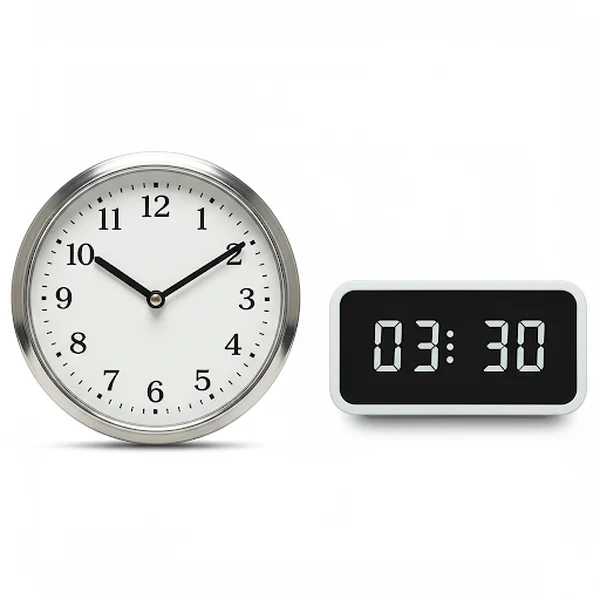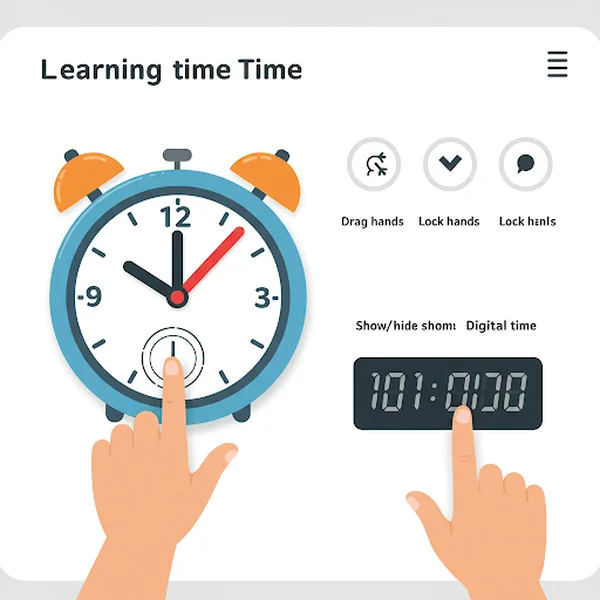Analog vs Digital Clock: Why Learning Both Matters
In today's fast-paced, digitally driven world, a quick glance at our smartphones or smartwatches instantly tells us the time. This raises a common question: What is the difference between an analog and digital clock, and with digital displays everywhere, is learning to read an analog clock still important? The answer is a resounding yes! Understanding both types of clocks enriches our grasp of time and offers unique cognitive benefits. Discover more about telling time and why this skill remains vital.
Analog or Digital? Unpacking the Importance of Learning Both Clock Types
Many wonder if the classic analog clock, with its moving hands, is becoming a relic of the past. While digital clocks offer undeniable convenience, the traditional analog clock provides a much deeper, more intuitive understanding of time's passage. Let's explore why mastering both analog and digital time-telling is essential for comprehensive time literacy.
What's the Real Difference? Analog vs Digital Clocks Unveiled
At first glance, the primary difference between clock types is their display. But this visual distinction leads to fundamental differences in how we perceive and interact with time. Are analog clocks still taught because of these differences? Absolutely.
The Analog Clock: A Visual Journey Through Time's Passage
An analog clock typically features a circular face with numbers 1 through 12, and two or three hands: an hour hand, a minute hand, and often a second hand. It offers a visual representation of time as a continuous flow. You see the hands physically moving, illustrating fractions of an hour like "half past" or "quarter to" in a way that a static digital display cannot. This helps in understanding time concepts beyond just numbers.

The Digital Clock: Instant Numbers for Quick Time Checks
Digital clocks, on the other hand, display time as instant numbers (e.g., 10:30). They offer immediate and precise readings, which is incredibly convenient for quick checks. There's no interpretation needed; the time is presented directly. This makes them efficient, but they don't inherently teach the concept of time in the same way an analog clock does.
Key Distinctions: Analog and Digital Clocks Side-by-Side
Here’s a quick comparison:
- Display: Moving hands on a numbered dial (analog) vs. numerical digits (digital).
- Reading: Requires interpretation of hand positions (analog) vs. direct numerical reading (digital).
- Time Perception: Shows time as a continuous, cyclical flow (analog) vs. discrete moments (digital).
- Learning Curve: Can initially be more complex (analog) vs. generally straightforward (digital).
- Benefits of Analog Clock: Deeper conceptual understanding of time, fractions, and duration.
Understanding these distinctions is key to appreciating why both clocks, digital and analogue, have their place.
Why Learning an Analog Clock is Still Crucial in a Digital World
Why are analog clocks better for learning in some respects, even with digital technology so prevalent? The unique way an analog clock displays time fosters crucial cognitive skills and a more profound understanding of time itself. For those asking, "Are analog clocks obsolete?", the educational and developmental benefits provide a strong counter-argument.
Developing a Deeper Understanding of Time Concepts (Not Just Numbers)
Reading an analog clock isn't just about identifying numbers; it's about understanding relationships and time concepts. Children learn about "half past," "quarter to," and how minutes accumulate into hours. They see the hour hand gradually move from one number to the next, providing a tangible sense of duration and the cyclical nature of time. This foundational understanding is something a digital display doesn't inherently provide.

Boosting Cognitive Skills: Spatial Reasoning and Estimation
Interpreting the angles and positions of the hands on an analog clock significantly enhances spatial reasoning. Children learn to judge relative positions and estimate time even if they can't see the minute markers perfectly. This skill of estimation and visual-spatial processing is a valuable cognitive benefit that extends beyond simply telling time.
Preparing for Real-World Encounters with Non-Digital Clocks
Despite the digital boom, non-digital clocks are still present in many environments – from classroom walls and public buildings to some watches and exam rooms. Being able to read an analog clock is a practical life skill that ensures individuals aren't caught off guard. It’s about comprehensive time literacy, not just relying on one format. For robust analog clock learning, practical tools are invaluable.
The Undeniable Advantages of Digital Clocks
It's important to acknowledge the strengths of digital clocks, which contribute to their widespread use. These clocks, digital and analogue, both serve valuable purposes.
Precision and Unambiguous Readouts for Efficiency
Digital clocks offer unparalleled precision and unambiguous readouts. When you need to know the exact time quickly, a digital display is highly efficient. There's no room for misinterpretation, which can be crucial in many situations.
Packed with Features: Alarms, Timers, and More
Digital technology allows for many integrated features like alarms, stopwatches, timers, and date displays, all within a compact device. This multifunctionality is a significant advantage of digital clocks.
The Best of Both Worlds: Why Comprehensive Time Literacy Includes Analog and Digital
Ultimately, the debate isn't about analog vs digital clock superiority, but about recognizing the unique value each brings. True time literacy involves being comfortable and proficient with both formats.
How Analog and Digital Skills Complement Each Other
The conceptual understanding gained from an analog clock (like understanding "20 minutes to 3") can enrich how one perceives digital time. Conversely, the precision of digital time can help confirm readings on an analog clock, especially during the learning process. The skills are complementary, leading to a more holistic understanding of time.
Tips for Parents & Teachers: Fostering Dual Clock Proficiency
How can you help children become proficient with both?
-
Start with the basics of an analog clock, focusing on the hour and minute hands separately.
-
Use an interactive tool. For instance, you can visit our website to experience an interactive clock that allows you to move the hands and see the digital time change simultaneously. This feature of our analog clock tool helps bridge the gap.
-
Practice regularly with both types of clocks.
-
Discuss time in different contexts, relating analog concepts to digital readouts.

Embracing Both Analog and Digital Clocks for Smarter Time Skills
While digital clocks offer speed and convenience, the analog clock provides indispensable benefits for developing a deep understanding of time, enhancing cognitive skills, and promoting spatial reasoning. Learning to read an analog clock is far from an obsolete skill; it's a cornerstone of comprehensive time literacy. Encouraging children to learn both types equips them with a more versatile and profound grasp of how time works.
Analog vs. Digital Clocks: Frequently Asked Questions
Are analog clocks becoming obsolete?
Not entirely. While digital displays are more common for quick time checks, analog clocks offer unique educational benefits for understanding time concepts and are still used in various settings. They remain highly relevant for analog clock learning and developing foundational time concepts.
Is it harder to learn an analog clock than a digital one?
Initially, learning to tell time on an analog clock can seem more complex due to interpreting hand positions and understanding fractions of an hour. However, this process builds valuable cognitive skills. Interactive tools, like the one available when you explore analogclock, can make learning engaging and bridge the understanding between analog and digital displays.
Why are analog clocks usually 12-hour based?
Historically, the 12-hour cycle for an analog clock was mechanically simpler to engineer for early clockmakers and aligned with the natural division of day and night (two 12-hour periods). This format has persisted due to tradition and its visual intuitiveness for teaching time.
Can tools like AnalogClock.net help in understanding both clock types?
Yes, definitely! Our interactive analog clock at analogclock allows users to move the analog hands and instantly see the corresponding digital time. This direct visual link is extremely helpful for understanding the difference between clock types and how they relate, reinforcing learning for both.
What are the main benefits of teaching children analog clocks first?
Teaching an analog clock first helps children build foundational time concepts, such as the flow of time, fractions (half-past, quarter-to), and estimation, before they encounter the direct numerical representation of digital clocks. This approach can foster a deeper, more intuitive understanding of time literacy.